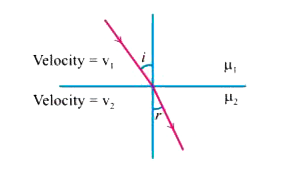Complete Solutions to VERY SHORT ANSWER QUESTION of chapter ELECTROMAGNETIC WAVES AND OPTICS of Class 12 book with complete answers and questions
| Class 12 | PHYSICS |
| Chapter | ELECTROMAGNETIC WAVES AND OPTICS |
| SUPPORT MATERIAL | VERY SHORT ANSWER QUESTION |
| Number Of Questions | 42 |
| Academic Year | 2023-24 |
Every EM wave has certain frequency. Name two parameters of an em wave that oscillate with this frequency.
02:11View SolutionIn electromagnetic wave, the phase difference between electric and magnetic field vactors E and B is
03:06View SolutionName em radiations used for detecting fake currency notes.
02:28View SolutionGive any two uses of microwaves.
01:01View SolutionName the phenomenon which justifies the transverse nature of em waves.
02:16View SolutionArrange the following em waves in descending order of wavelengths : γ ray, microwaves UV radiations.
01:39View SolutionWrite expression for speed of em waves in a medium of electrical permittivity `in` and magnetic permeability `mu`
02:04View SolutionWhich of the following has longest penetration power? UV radiation, X-ray, Microwaves.
02:42View SolutionWhich of the following has least frequency ? IR radiations, visible radiation, radio waves.
01:44View SolutionWhich physical quantity is the same for microwaves of wavelength 1 mm and UV radiations of 1600 A° in vacuum?
02:23View SolutionName two physical quantities which are imparted by an em wave to a surface on which it falls.
01:41View SolutionName the physical quantity with unit same as that of `|in_0 (d_ phi)/(dt)|` where `phi_e to` electric flux.
02:10View SolutionWhat is the source of energy associated with propagating em waves?
01:13View SolutionA mirror is turned through `15^(@)`. Through what angle will the reflected ray turn ?
01:27View SolutionName the device used for producing microwaves.
01:06View SolutionRelative electric permittivity of a medium is 9 and relative permeability close to unity. What is the speed of em waves in the medium.
02:02View SolutionIdentify the part of the electromagnetic spectrum to which the following wavelengths belong :
`10^-1m`01:01View SolutionIdentify the part of the electromagnetic spectrum to which the following wavelengths belong :
`10^-12m`02:03View SolutionName the part of the electromagnetic spectrum of wavelength `10^(-2)m` and mention its one application.
01:43View SolutionWhich of the following, if any, act as a source of electromagnetic waves? (i) A charge moving with a constant velocity (ii) A charge moving in a circular orbit (iii) A charge at rest.Give reason.
02:01View SolutionMention the pair of space and time varying E and B fields which would generate a plane em wave travelling in Z-direction.
View SolutionThe charging current for a capacitor is 0.2A. What is the displacement current?
01:06View SolutionGive the ratio of velocities of light rays of wavelength 4000Å and 8000Å in vacuum.
01:42View SolutionWhich physical quantity has the same value for waves belonging to the different parts of the electromagnetic spectrum?
02:23View SolutionWrite the value of angle of reflection for a ray of light falling normally on a mirror.
01:16View SolutionHow does the dispersive power of glass prism change when it is dipped in water?
02:01View SolutionName the phenomenon due to which one cannot see through fog.
01:49View SolutionWhat is the ratio of sin i and sin r in terms of velocities in the given figure.
 View Solution
View SolutionWhat is the shape of fringes in Youngs double slit experiment ?
View SolutionA equiconcave lens of focal length 15 cm is cut into two equal havles along dotted lines as shown in figure. What will be new focal length of each half.
 01:45View Solution
01:45View SolutionFor the same value of angle of incidence, the angles of refraction in three media A, B and C are `15^(@), 25^(@) and 35^(@)` respectively. In which medium would the velocity of light be minimum ?
02:12View SolutionWhat is the phase difference between any two points on a spherical wavefront?
01:35View SolutionWhat is the ‘power’ of plane glass plate ?
02:17View SolutionHow does focal length of lens change when red light incident on it is replaced by violet light?
02:10View SolutionLower half of the concave mirror is painted black. What effect will this have on the image of an object placed in front of the mirror?
01:56View SolutionAn air bubble is formed inside water. Does it act as a converging lens or a diverging lens ?
02:45View SolutionA water tank is 4 meter deep. A candle flame is kept 6 meter above the level `mu` for water is `4//3`. Where will the image of the candle be formed?
02:14View SolutionThe ratio of contributions made by the eletric field and magnetic field components to the intensity of an `EM` wave is.
01:29View SolutionAn EM wave of intensity ‘I’ falls on a surface kept in vacuum. What is the radiation pressure if wave is totally reflected?
02:10View SolutionIn a single slit diffraction pattern, how does the angular width of central maxima change when slit width is decreased
02:18View SolutionIn a single slit diffraction pattern, how does the angular width of central maxima change when distance between slit & screen is increased
02:29View SolutionIn a single slit diffraction pattern, how does the angular width of central maxima change when light of smaller visible wavelength is used ? Justify your answer.
03:07View Solution
VERY SHORT ANSWER QUESTION questions and complete solutions for chapter ELECTROMAGNETIC WAVES AND OPTICS of CBSE COMPLEMENTARY MATERIAL PHYSICS (HINGLISH) of Class 12
